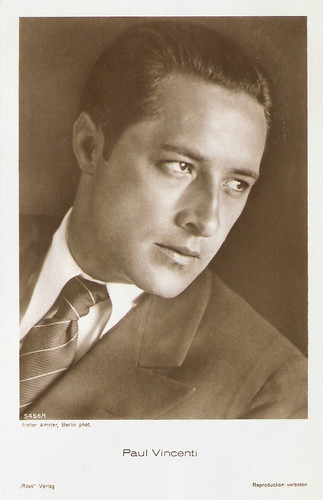
German postcard by Ross Verlag, Berlin, no. 5456/1, 1930-1931. Photo: Atelier Amster, Berlin. Paul Vincenti.

German postcard by Verlag Ross, Berlin, no. 1090/1, 1927-1928. Photo: Paramount-Film. Rudolph Valentino.
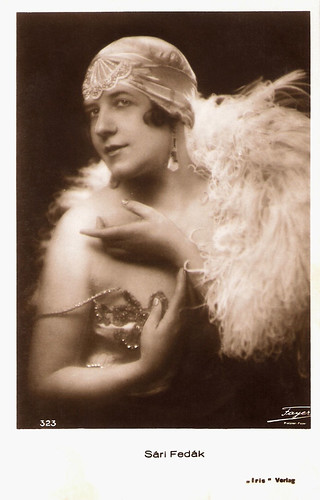
Austrian postcard by Iris Verlag, no. 323. Photo: Fayer. Sári Fedák.
Hungarian actress and singer Sári Fedák (1879-1955) was one of the most famous prima donnas of her time. The temperamental operetta and film star was mixed up in several scandals.

German postcard by Film-Foto-Verlag, no. G 262, 1941-1944. Photo: T. von Mindszenty.
Pretty Hungarian actress Lili Muráti (1914-1963) appeared in nearly 40 films between 1935 and 1995. She was a leading star of the Hungarian cinema in the 1930s. Her role in David Lean’s Dr. Zhivago (1965) became the subject of an urban legend.
The challenge of building a star
Tibor von Mindszenty was born in 1899 in Budapest, then Austria-Hungary. He was also known as Tibor Mindszenty and Tibor Mindszenthy and became known as Paul Vincenti in Hollywood.
He spent his childhood in Italy, Vienna and Budapest. At the age of 17, he was enlisted into the army and served in the First World War as an artillery lieutenant. His greatest passion was sports but to have a civilian position after he was discharged, he took a managerial post in his brother-in-law’s business.
During a boat trip on the Danube, he met celebrated actress Sári Fedák. When the renowned artiste caught sight of the handsome, sporty young man, she thought Mindszenty was the spitting image of Rudolph Valentino. Valentino, who personified the first screen ideal of the Latin heart-throb, died unexpectedly at the age of 31 in August 1926.
Fedák took on the challenge of building a star and clinching a lucrative deal by selling the Americans this Rudolph Valentino doppelgänger. She had screen tests made of Mindszenty at Corvin studio, and she took him to Angelo, the famous star photographer in Pest. A series of portraits published in Színházi Élet proved that Mindszenty could be the next Valentino. In November 1926, Mindszenty and Fedak set off for America.
Mindszenty was initially contracted to First National Film Studio in New York, then in 1929 he joined Fox for a short time. First National’s PR team started to build the image of the new star. One of the most important elements of the campaign was that the actor was heralded as the scion of an ‘ancient Hungarian hussar family’. It is no mere coincidence that his first minor role was in the Hungarian-themed film The Stolen Bride (1927) directed by Alexander Korda and starring Billie Dove. Later on, he appeared in The Love Mart (George Fitzmaurice, 1927) with Billie Dove and Gilbert Roland and he took the lead in the melodrama The Veiled Woman (Emmett J. Flynn, 1929). Mindszenty worked under the catchy stage name of Paul Vincenti from 1927.

German postcard by FBZ, no. 225. Photo: Merkur-Film / T. v. Mindszenty. Cornell Borchers and Willy Birgel in Das ewige Spiel/The eternal game (Frantisek Cáp, 1951).

West-German postcard by Kunst und Bild, Berlin, no. A 658. Photo: T. v. Mindszenty / Herzog Film. Germaine Damar in Tanzende Sterne/Dancing Stars (Géza von Cziffra, 1952).
Luxembourg actress and dancer Germaine Damar (1929) started her career as an acrobat. She played in nearly 30 German films, including three films in which she was the partner of Peter Alexander.

German postcard by Kunst und Bild, Berlin, A 585. Photo: Europa-Film / V. Mindszenty. Albert Lieven in Klettermaxe/Corry Bell (Kurt Hoffmann, 1952).
German character actor Albert Lieven (1906–1971) fled from Nazi Germany to Great Britain. During WW II, he appeared in several British films, often cast as the humourless military. Till the 1970s, he appeared in German and British films and on television.

East-German postcard by VEB Volkskunstverlag Reichenbach I.V., no. G 708, 1956. Photo: Von Mindszenty. Ingeborg Körner in Keine Angst vor großen Tieren/Not Afraid of Big Animals (Ulrich Erfurth, 1953).

East-German postcard by VEB Volkskunstverlag Reichenbach I.V., no. G 707, 1956. Photo: Von Mindszenty. Ingeborg Körner in Keine Angst vor großen Tieren/Not Afraid of Big Animals (Ulrich Erfurth, 1953).
Ingeborg Körner (1929) is a Namibian-born German actress, best known for her parts in such West-German films as Die Rose von Stambul/The Rose of Stamboul (1953), Keine Angst vor großen Tieren/Not Afraid of Big Animals (1953) and Das ideale Brautpaar/The Perfect Couple (1954). from 1955 on she only appeared on German TV and stage.
The Hungarian connection in Berlin
When his contract expired, Tibor von Mindszenty returned to Europe. He settled in Berlin where he appeared in six films between 1929 and 1934. One of these was the Czech-German coproduced late silent film Kennst du das kleine Haus am Michigansee?/Do You Know That Little House on Lake Michigan? (Viktor Brumlík, Max W. Kimmich, 1929). The story is set in the United States but scenes around the picturesque Lake Michigan were actually shot in the High Tatras.
In the film, Vincenti is a bored playboy whose only passion is water sports until he meets a pretty girl. Critics of the time praised the romantic atmosphere given by nature and Vincenti was deemed to be convincing as the handsome, tough character who was considered by Siegfried Kracauer, critic of Frankfurter Zeitung, to be “both sporty and erotic”.
All his other films from the Berlin period have some Hungarian connection, either as regards the cast and crew or the subject matter. Géza von Bolváry directed Ein Tango für Dich (Géza von Bolváry, 1930) with Ernő Verebes and Tibor Halmay and Der Raub der Mona Lisa/The Theft of the Mona Lisa (Géza von Bolváry, 1931). Seitensprünge (1931), the second film directed by István Székely, was made on the basis of the screenplay by Károly Nóti and Lajos Bíró.
The screenwriters of the musical romance Mein Herz ruft nach Dir/My Heart Calls You (Carmine Gallone, 1934) were Ernst Marischka and Emeric Pressburger, and the editor was Eduard von Borsody. Mein Herz ruft nach Dir is about an opera company and it became famous because Márta Eggerth and Jan Kiepura – one of the most famous dream pairs on the screen – played together in it for the first time. Hilde von Stolz, who was born in Sighișoara (then part of Hungary), had a supporting role.
Vincenti also played in Die Csikósbaroness (Jacob Fleck, Luise Fleck, 1930), one of the typical Hungarian-themed German films of the early sound era. It tells the story of a love affair between a German baroness and a Hungarian hussar officer. The musical film was shot in Hunnia Film Studio, Budapest, in Debrecen and on the Hortobágy. Ernő (Ernst) Verebes and Gretl Theimer play the other two lead roles. The film received mixed reviews from audiences and critics.

German postcard by K & B / Filmwelt Berlin Archiv für Film-Geschichte, no. 57. Photo: Deutsche London Film / T. von Mindszenty. Heinz Rühmann and Ingeborg Körner in Keine Angst vor großen Tieren/Not Afraid of Big Animals (Ulrich Erfurth, 1953).
Actor, director and producer Heinz Rühmann (1902-1994) played in more than 100 films over nearly 70 years and was one of Germany's most popular film stars. He was a favourite actor of Adolf Hitler and Joseph Goebbels but also of Anne Frank. She pasted his photo on the wall of her room in her family's hiding place during the war, where it can still be seen today.
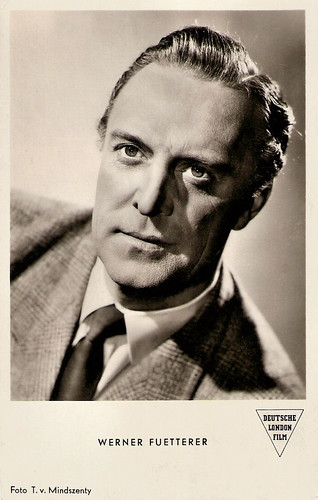
German postcard by Kunst und Bild, Berlin, no. A 838. Photo: T. von Mindszenty / Deutsche London Film. Werner Fuetterer in Keine Angst vor grossen Tieren/Don't Fear Big Animals (Ulrich Erfurth, 1953).
At the age of 18, German actor Werner Fuetterer (1907-1991) was discovered to play the young lover in a series of silent films. For more than four decades he went on to work as a supporting actor in nearly 100 films.
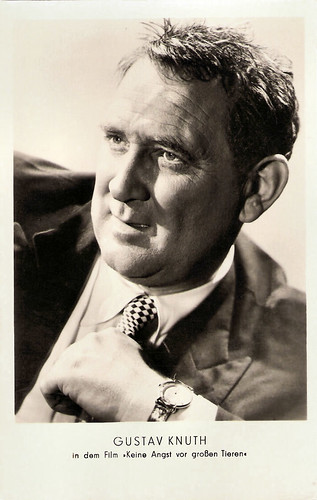
East-German postcard by VEB Volkskunstverlag Reichenbach i.V., no. G 7C6. Photo: Real / v. Mindszenty, 1956. Gustav Knuth in Keine Angst für grossen Tieren/Not Afraid of Big Animals (Ulrich Erfurth, 1953).
Gustav Knuth (1901-1987) was a German actor who played folksy, good-natured characters in numerous films and TV series. After the Second World War, he took Swiss citizenship. He was a successful stage actor and starred in more than 120 films between 1935 and 1982. During the 1960s and 1970s, he was one of the most distinguished German TV actors.

German postcard by Kunst und Bild, no. A 1189. Photo: T. v. Mindszenty / Deutsche London (TLF). Carl Raddatz in Geständnis unter vier Augen/Confession Under Four Eyes (André Michel, 1954).
German actor Carl Raddatz (1912-2004) was much in demand by film producers in the 1940s and especially in the 1950s. He appeared in several Nazi propaganda films, but he also gave Joseph Stalin a German voice. Through the years he would become one of the leading character actors of the German theatre.
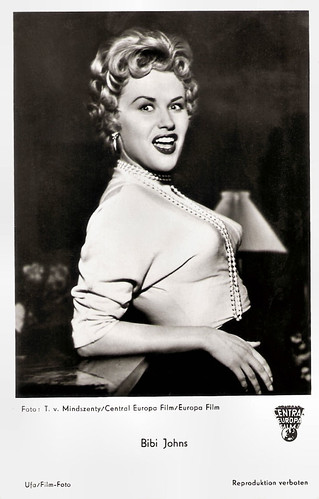
German postcard by Ufa, Berlin-Tempelhof, no. FK 1647. Photo: T. v. Mindszenty / Central Europa Film / Europa Film. Bibi Johns in Ball im Savoy/Ball at the Savoy (Paul Martin, 1955).
Blond Swedish pop singer and actress Bibi Johns (1929) was very popular in Europe and the USA during the 1950s. She appeared in several European musical films. In Germany, where she lived from 1954 on, she would become a cult star of the Schlager music. Today she is also known as a painter.
A true expert in the European star system
Perhaps this reception contributed to the fact that in the second half of the 1930s, Tibor von Mindszenty decided to open a totally new chapter in his life. Having studied photography in America, he found that he preferred to work behind the camera in the German capital.
He opened a photography studio and became a star photographer specialising in the fashionable trends of the era. Maybe he never forgot how much he owed photographer Angelo in Budapest because he also took his new profession extremely seriously. He worked on studio portraits and commercial photos primarily for Ufa film stars and magazines, and, interestingly, he signed off his works once again as ‘Mindszenty’ and ‘T. v. Mindszenty’.
Soon he had trained himself as a true expert of the European star system and his photographs served as references for the studios. In 1943, at the request of Ufa, he returned to Hungary to make a photo series of local stars and he also received orders that if he came across suitable young talents, he should notify the Berlin centre.
In an interview made in 1943, he said that he belonged to the circle of friends of directors Géza von Bolváry and József von Baky in Berlin. After the war, he continued working as a still photographer in Germany.
During the 1950s he worked on such German films as the romantic comedy Fanfaren der Liebe/Fanfares of Love (Kurt Hoffmann, 1951) starring Dieter Borsche, the musical comedy Geld aus der Luft/Money from the Air (Geza von Cziffra, 1955) with Lonny Kellner, and the crime drama Banditen der Autobahn/Bandits of the Highway (Geza von Cziffra, 1955) with Eva Ingeborg Scholz and Hans Christian Blech. During the early 1960s, Tibor von Mindszenty worked as a production manager for German television. When and where he passed away is unknown.
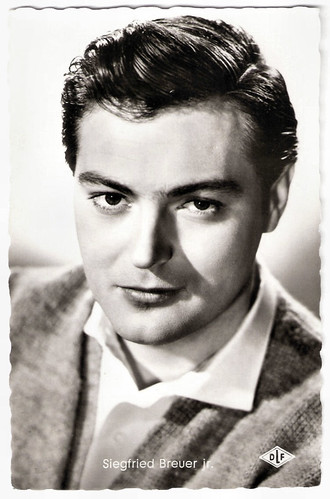
German postcard by Kolibri-Verlag, Minden-Westf., no. 1961. Photo: Deutsche London / Von Mindszenty. Publicity still for Die gestolene Hose/The Stolen Trousers (Géza von Cziffra, 1956).
Siegfried Breuer Jr. (1930-2004) was an Austrian film actor. He often played jeune premiers in German films of the 1950s and early 1960s.

German postcard by WS-Druck, Wanne-Eickel, no. 22. Photo: Arca / NF / V. Mindszenty.
German actor Walter Giller (1927-2011) was the cute boy-next-door in German films of the 1950s. With Nadja Tiller, he became a Dream Couple in European cinema.

German postcard by Ufa, Berlin-Tempelhof, no. FK 3302. Photo: v. Mindszenty / Real-Film / Rank Film. Publicity still for Drei Birken auf der Heide/Three birches on the heath (Ulrich Erfurth, 1956).
German actress Margit Saad (1929) was a mysterious, exotic beauty working largely in German film and television. During the 1960s, she also made occasional English-language appearances.

West-German postcard by Ufa/Film-Foto, Berlin-Tempelhof, no. 1652. Photo: T. v. Mindszenty / Central Europa Film / Europa Film. Eva Ingeborg Scholz in Ball im Savoy/Ball at the Savoy (Paul Martin, 1955).

West-German postcard by Kolibri-Verlag G,m.b.H., Minden/Westf., no. 1635. Photo: Real / Rank-Film / v Mindszenty. Eva Ingeborg Scholz in Unternehmen Schlafsack/Operation Sleeping Bag (Arthur Maria Rabenalt, 1955).
Since her East German debut in 1948, German film and television actress Eva Ingeborg Scholz (1928-2022) played in more than 110 film and television productions.
Sources: Barkóczi Janka (National Film Institute Hungary), Filmportal.de and IMDb.
1 comment:
Tibor von Mindszenty's transformation from Hollywood actor Paul Vincenti to a prominent Ufa photographer is truly fascinating. check out Zenith Clipping. Their professional editing services can help bring your creative vision to life. Keep creating and inspiring! 🎨
Post a Comment